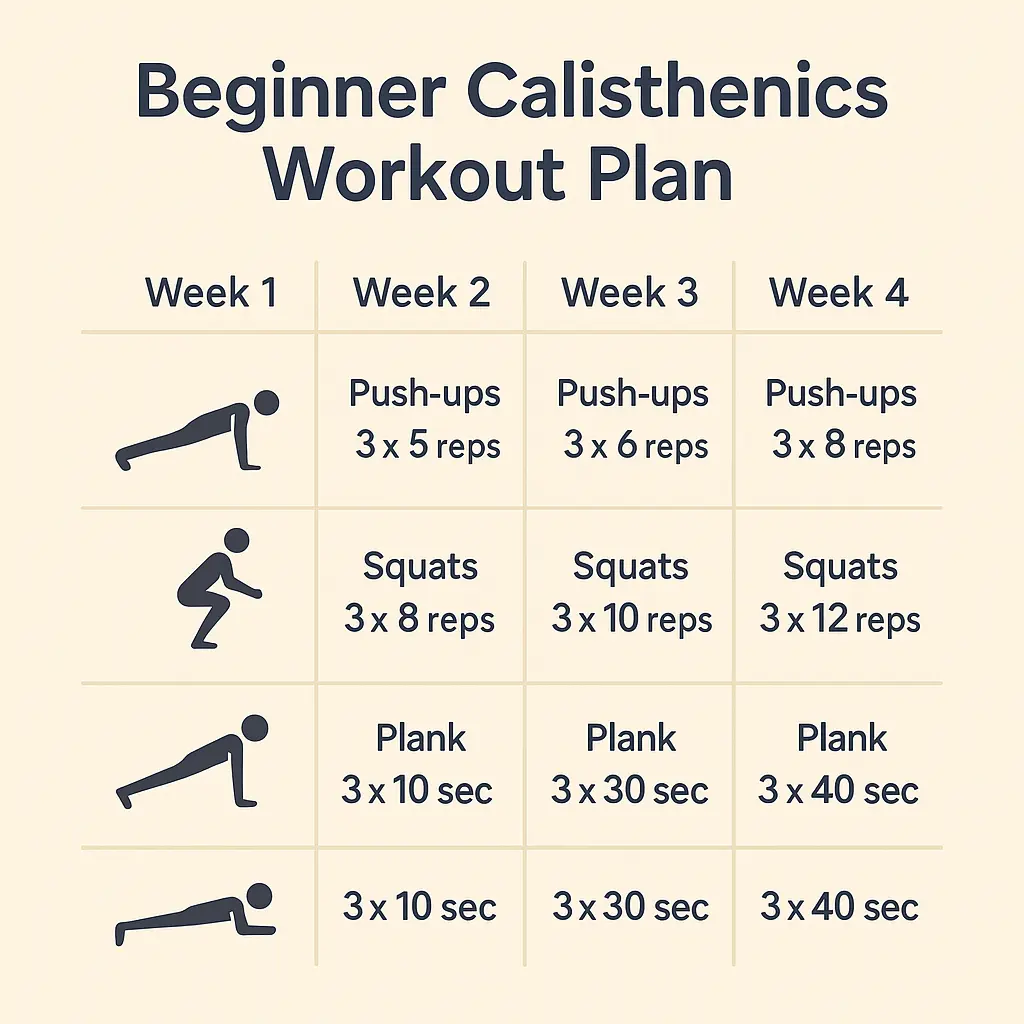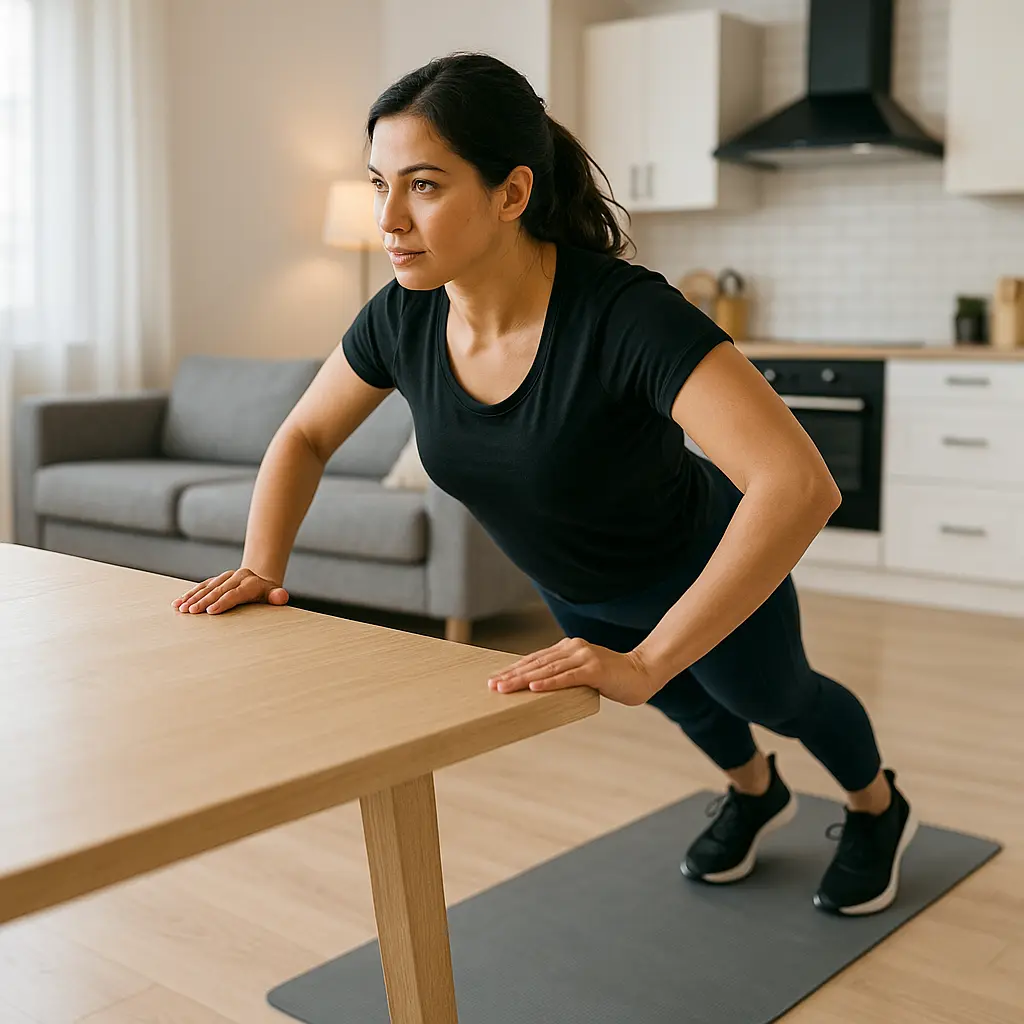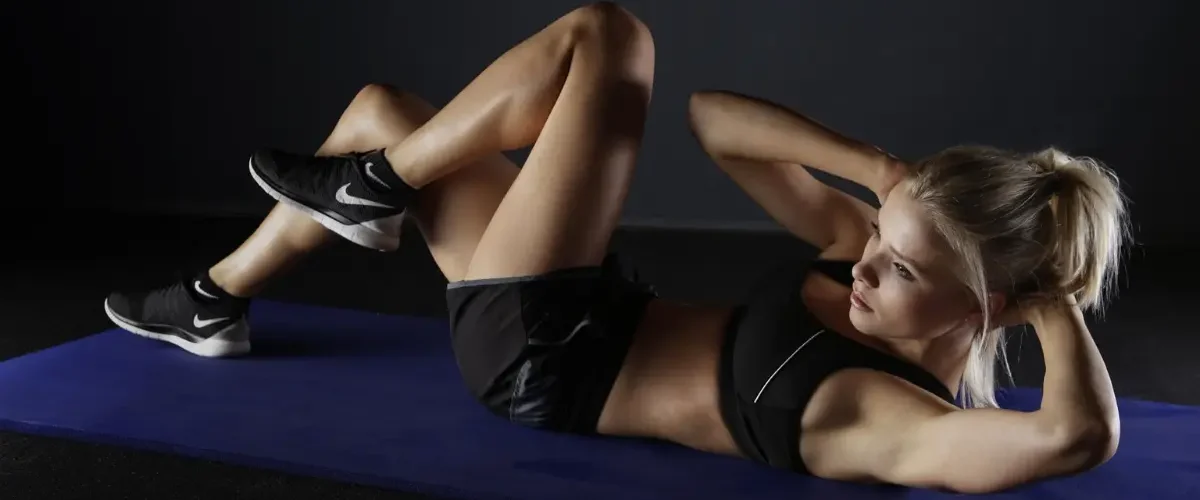Think back to the last time you tried a single push-up and gravity felt like an immovable wall. In that split second you probably wondered, “If I can’t move my own body, how will I ever get fit?” The answer sits in the very thing that humbled you—body-weight training. Calisthenics isn’t just exercise; it’s the art of turning everyday movements into powerful strength builders, and it asks for nothing but your determination, a small patch of floor, and maybe a pull-up bar nailed to a doorway.
This in-depth guide hands you a step-by-step calisthenics workout plan for beginners, built to transform shaky first reps into rock-solid full-body control within four weeks. You’ll discover why calisthenics outperforms many equipment-heavy programs, learn smart progressions that protect your joints, and pick up recovery tactics that keep soreness from derailing momentum. Strap in—your new training journey starts the moment you finish this page.
Table of Contents
Why a Beginner Calisthenics Workout plan Belongs in Your Life
1. Functional Strength for Real-World Tasks
You lift groceries, climb stairs, and shove furniture around far more often than you bench-press barbells. Calisthenics mirrors those natural patterns, improving push, pull, hinge, and squat mechanics so your body works better during every mundane chore. Studies from the American Council on Exercise (ACE) show that body-weight routines rival free weights for activating core stabilizers—meaning you’ll not only grow stronger but also boost posture and balance.
2. Zero Equipment, Zero Excuses on calisthenics workout plan
A gym membership can cost more than your phone bill; calisthenics costs the spare change hiding in your sofa cushions. You need:
- Floor space wide enough for a plank
- Sturdy pull-up bar (door-frame or playground)
- Optional resistance band for assisted pulling moves
That’s it. Your training ground could be a bedroom, hotel room, or sunny patch of park grass. Travel, holidays, and tight budgets stop being obstacles the instant you adopt body-weight workouts.
3. Joint-Friendly, Beginner-Safe Progressions
Because you control leverage by elevating hands, bending knees, or shortening ranges of motion, calisthenics scales down to meet true novices instead of forcing them into advanced loads. Combined with appropriate rest—48 hours between sessions for the same muscle group, per National Strength & Conditioning Association (NSCA) guidelines—these progressions lower injury risk while still pushing adaptation.
Readiness Check: Gear, Space & Safety Must-Dos ( Calisthenics Workout plan )
- Inspect your training area. Make sure the floor is non-slip, the ceiling high enough for overhead arms, and the pull-up bar rated to hold more than your body weight.
- Run a 5-minute joint warm-up (see next section) before every session. Cold tendons tear; warm ones stretch.
- Track your initial benchmarks—maximum incline push-ups, plank hold time, body-row reps. These numbers provide Day-1 data for future bragging rights.
- Clear health concerns. If you have uncontrolled blood pressure, recent surgeries, or chronic pain, get a professional “green light” first.
Quick tip: Film your first set of every new move. The camera doesn’t lie; it shows sagging hips, flared elbows, or knee collapse that you’ll correct in the very next rep.
Dynamic Warm-Up: Five Minutes to Prep Every Joint (Calisthenics Workout plan )
| Move | Duration / Reps | Purpose |
|---|---|---|
| Arm circles (forward & backward) | 30 s each direction | Primes shoulder joints |
| Hip openers | 10 reps each side | Loosens hip capsules for deeper squats |
| Cat–cow spine flow | 8 slow cycles | Mobilises thoracic & lumbar spine |
| Inchworm walkouts | 5 reps | Activates core while stretching hamstrings |
| Jumping jacks | 60 s | Elevates heart rate & neural drive |
That’s a total of five minutes, enough to raise core temperature and lubricate major joints without draining energy reserved for your working sets.
The Four-Week Beginner Calisthenics Workout Plan
Schedule: Train Monday, Wednesday, Friday (or any three non-consecutive days). Each workout hits complementary patterns so muscles recover while you rest.
| Week | Day 1 – Push & Core | Day 2 – Pull & Legs | Day 3 – Full-Body Circuit |
|---|---|---|---|
| 1 | Incline push-up 3×8Dead bug 3×10 | Bent-knee body-row 3×6Air squat 3×10 | 3 rounds: 5 burpees • 10 lunges • 20 s plank |
| 2 | Knee push-up 3×10Hollow hold 3×20 s | Banded body-row 3×8Reverse lunge 3×10 | 4 rounds: 6 burpees • 12 squats • 25 s plank |
| 3 | Standard push-up 3×8Dead bug 3×12 | Assisted pull-up 3×5Jump squat 3×8 | 4 rounds: 8 burpees • 14 lunges • 30 s plank |
| 4 | Diamond push-up 3×6-8Hollow hold 3×30 s | Negative pull-up 3×4Chair pistol squat 3×6/leg | 5 rounds: 10 burpees • 16 squats • 35 s plank |
Programming notes


- Progressive overload arrives through added reps, slower tempo, or harder leverages (e.g., higher foot incline).
- Keep rest intervals around 60–90 seconds for strength blocks; circuit days rest only as long as needed to maintain form.
- On Week 4, retest maximum floor push-ups and plank time—expect a 30–40 percent jump versus Day 1 if you’ve been consistent.
Mastering Technique: Your How-To Library on calisthenics workout plan
Push Domain: Push-Ups & Dips
- Hand placement: slightly wider than shoulder width; point index fingers forward.
- Body line: ears-to-heels straight; avoid sagging hips.
- Elbow angle: approximate 45° relative to ribs—this spares shoulder joints.
- Progress flow: wall → countertop → kneeling → full push-up → decline push-up.
Pull Domain: Rows & Assisted Pull-Ups
- Scapular initiation: begin each rep by squeezing shoulder blades together; think “chest up, shoulders back.”
- Assistance options: loop a resistance band over the bar or keep feet on the floor for body-rows until you can pull your full weight.
- Tempo cue: 1 sec pull, 3 sec controlled lower—the eccentric phase builds the most strength.
Core Staples: Hollow Holds & Dead Bugs
- Spinal contact: press lower back firmly into the floor; if it arches, raise your legs or arms to shorten the lever.
- Breathing: exhale on the “hard” part—usually when limbs extend—so your deep abdominal muscles (transversus abdominis) learn to brace.
Lower-Body Drivers: Squats, Lunges, Pistols
- Knee tracking: send knees along the same line as second toes.
- Depth: squat until thighs are at least parallel; stop before tailbone tucks under (“butt-wink”).
- Pistol regressions: box pistol or assisted TRX pistol before freestanding singles to avoid knee strain.
Coaching hack: Think “slow on the way down, explode up.” Controlling descent protects joints and recruits stabilizers; explosive drives wake fast-twitch fibers for strength gains.
Recovery & Fuel: Simple Ingredient Table for calisthenics workout plan
| Goal | Snack Idea | Core Ingredients | Why It Works |
|---|---|---|---|
| Muscle repair | 25 g protein shake | Whey + water + ripe banana | Delivers amino acids & glycogen |
| Joint support | Berry-spinach smoothie | 1 c berries • handful spinach • 1 Tbsp chia | Antioxidants curb inflammation; omega-3s feed cartilage |
| Hydration | DIY electrolyte water | 500 ml water • pinch sea salt • squeeze lemon | Replaces sodium lost in sweat; vitamin C aids tissue repair |
Timing rule: aim to refuel within 45 minutes post-workout—the metabolic “window” when muscles crave nutrients for rebuilding.
Tracking Progress & Staying Motivated (Calisthenics Workout plan)
- Log every rep. Use a spreadsheet or fitness app to record sets, reps, rest, and Rate of Perceived Exertion (RPE).
- Celebrate micro-wins: your first floor push-up, a 30-second longer plank, or dropping assistance bands on pull-ups.
- Gamify: set streak challenges—e.g., never miss Monday workouts for eight straight weeks; reward yourself with new workout gear.
- Community counts: post session recaps on social (#CalisthenicsStarter) or join a Reddit body-weight forum for peer coaching.
Momentum mantra: “More today than yesterday, less than tomorrow.” Small, steady climbs beat heroic leaps that flame out.
Common Beginner Mistakes & How to Dodge Them
- Skipping warm-up → tight muscles, higher injury risk.
- Ego over form → sloppy reps limit strength gains; quality beats quantity.
- Neglecting pull movements → push-dominant routines round shoulders and invite imbalance.
- Poor sleep and nutrition → progress stalls if recovery lags; aim for 7–9 hours of sleep and balanced macros.
- Program hopping → stick to this four-week plan before hunting new stimuli; adaptation requires consistency.
FAQ – Beginner Calisthenics Workout plan Essentials
Q 1: How often should I do this plan?
A: Three non-consecutive days each week hit the sweet spot for stimulus and recovery. Light mobility or walking is fine on rest days.
Q 2: Do I need special equipment?
A: Just a sturdy pull-up bar and, if desired, a resistance band for assistance. Floor space and gravity handle the rest.
Q 3: Will this routine help me lose fat?
A: Yes. Body-weight circuits raise heart rate, and the muscle you gain boosts resting calorie burn. Combine training with a slight calorie deficit for best results.
Q 4: When can I progress to intermediate moves like dips or handstands?
A: Once you can perform 3 × 12 standard push-ups and 3 × 6 controlled negative pull-ups with perfect form and no joint pain.
Q 5: What if I feel joint pain during or after exercises?
A: Stop immediately, review your form, and regress the movement (e.g., elevate hands or use more band assistance). Persistent discomfort warrants a physio check-up before continuing.
Conclusion – Your Roadmap to Body-Weight Mastery Starts Now
You opened this guide with one goal—figuring out how to make your body stronger without drowning in gym fees or complex machines. Now you hold a four-week calisthenics workout plan that scales from shaky Day-1 incline push-ups to confident floor reps and assisted pull-ups. You understand warm-ups, progressions, recovery nutrition, and motivation hacks, plus you’ve got rapid-fire answers to the biggest beginner questions.
Here’s your next move:
- Screenshot the training table above or print it out.
- Commit to Day 1 right now—yes, today—before excuses multiply.
- Share your first session stats on social (#calisthenics workout plan) on our blog
- and tag a friend to join you; accountability is rocket fuel for habit building.
Every future push-up, pull-up, and pistol squat starts with the decision you make in this very moment. So roll out the mat, grab that stopwatch, and discover exactly how powerful your own body can become—no fancy equipment required.



4 Responses